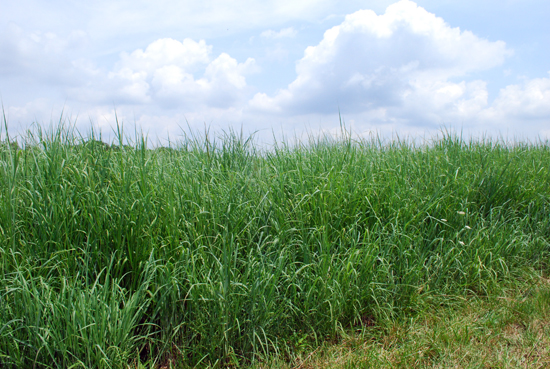Switchgrass project a success
Switchgrass project a success

In 2007, University of Kentucky College of Agriculture forage specialists, East Kentucky Power Cooperative personnel and 20 farmers in northeastern Kentucky began a pilot project looking at the biomass potential of switchgrass, a warm-season forage native to Kentucky.
Several factors have limited the current biomass market, but Ray Smith, UK extension forage specialist, said the project was still a success.
“We learned a whole lot and found some useful applications for the forage until a consistent biomass market develops,” said Smith, who was the primary investigator on the project.
The research project, directed by UK hay specialist Tom Keene and funded by the Kentucky Agricultural Development Fund, has yielded better recommendations for establishing switchgrass as forage, an economic spreadsheet farmers can utilize to determine if switchgrass would be a good option for their operation, documented environmental benefits of the crop and possibly a more cost effective way to make the product easier to transport and handle.
Smith said half of the original group of farmers still have productive stands of switchgrass and are cutting it for hay or grazing cattle on it, as it thrives during the hot, dry months of summer when cool-season grasses struggle. He said the producers were extremely pleased with switchgrass’ production and quality during the 2012 drought.
“One of the primary reasons why we selected switchgrass for this project was because it showed great promise as a dual purpose crop,” Smith said.
UK researchers found that producers could take an early cutting of switchgrass for hay and harvest it in late fall for a biomass crop without a significant yield loss, which is promising if a market develops. Former UK graduate student David Davis conducted a study in 2011 that showed when switchgrass is harvested at a leafy stage, it has acceptable digestibility and protein that growing steers need.
The pilot project also showed the forage’s beneficial environmental enhancements. UK graduate student Laura Schwer found that switchgrass’ deep root system can control erosion, improve soil quality and sequester carbon. The forage’s dense canopy, abundant seeds and clear understory make it an excellent wildlife habitat for small mammals. The presence of small mammals is an indicator of overall ecosystem health.
Smith, along with UK agricultural economist Greg Halich, developed an interactive spreadsheet for farmers to compare their current production costs for hay and the production costs of switchgrass as a biomass if a market develops. They found that producers would need to receive $64 per ton of biomass to break even on the crop.
“Producers must be able to realize the economic benefits of switchgrass before they can justify moving land out of hay or crop production,” Smith said. “This tool allows producers to determine whether switchgrass is more profitable than hay for their farming operation before they sign long-term biomass production contracts.”
Throughout the study, UK researchers looked for several ways to mitigate transportation and handling costs for producers and the power company—two of the biggest limiting factors for using switchgrass as a biomass. In 2011, UK purchased two mobile briquetting units, so producers could turn switchgrass into briquettes on the farm. Putting switchgrass into a briquette makes it easier to transport compared to large, round bales. It also made mixing the switchgrass with coal much easier for the power company. Smith said briquetting units are expensive, however, and producers would likely have to purchase a unit as group or cooperative to keep production costs low.
He added that he has begun a different research project funded by the Natural Resources Conservation Service to look at other opportunities for switchgrass beyond biomass production. That project will go through 2014. UK forage specialists are continuing to look at forage options for biomass production.
Community Development Crops Extension


